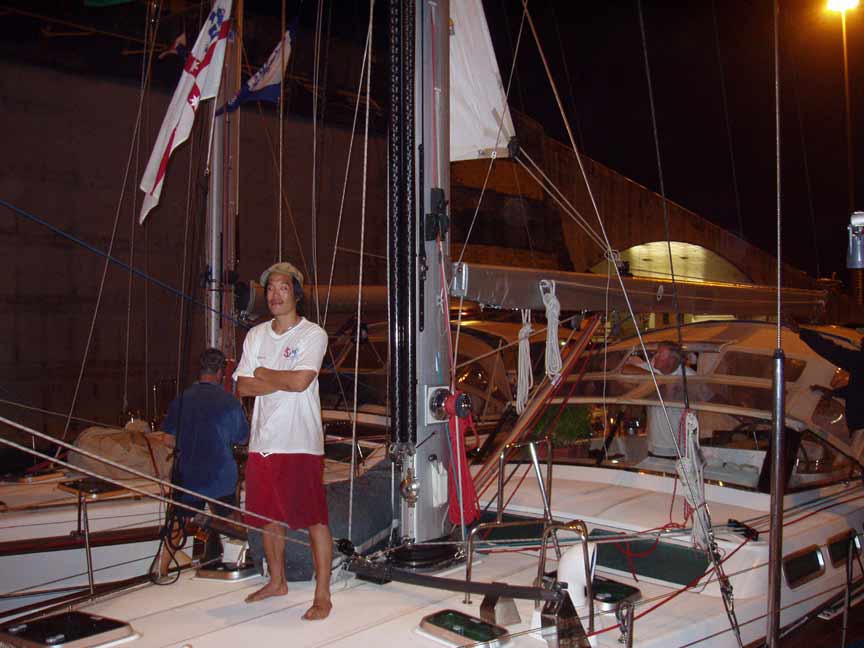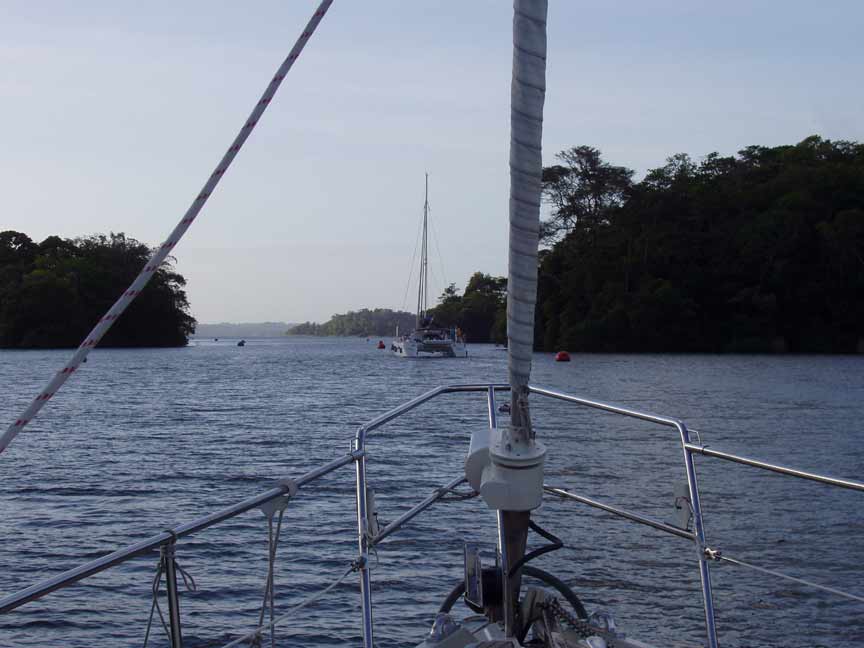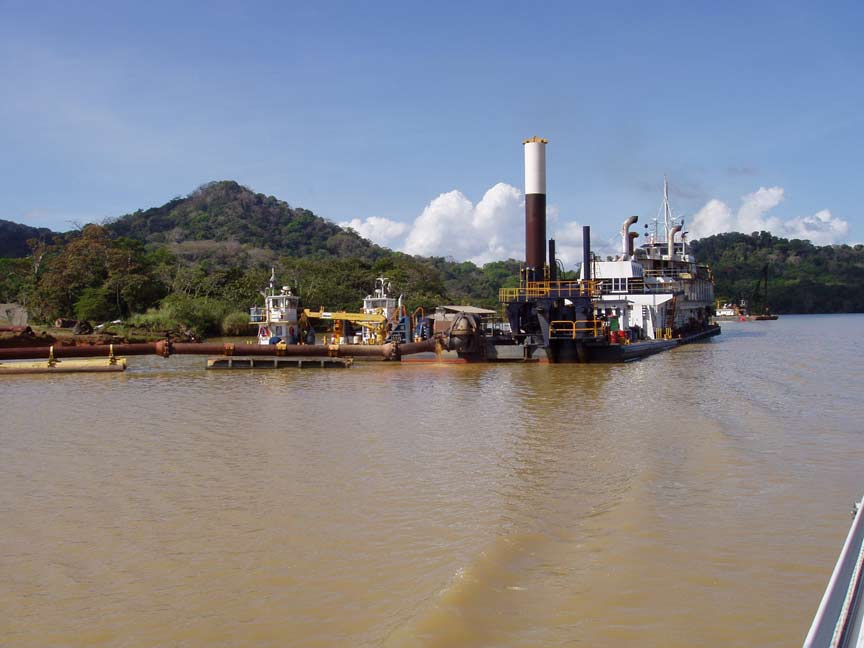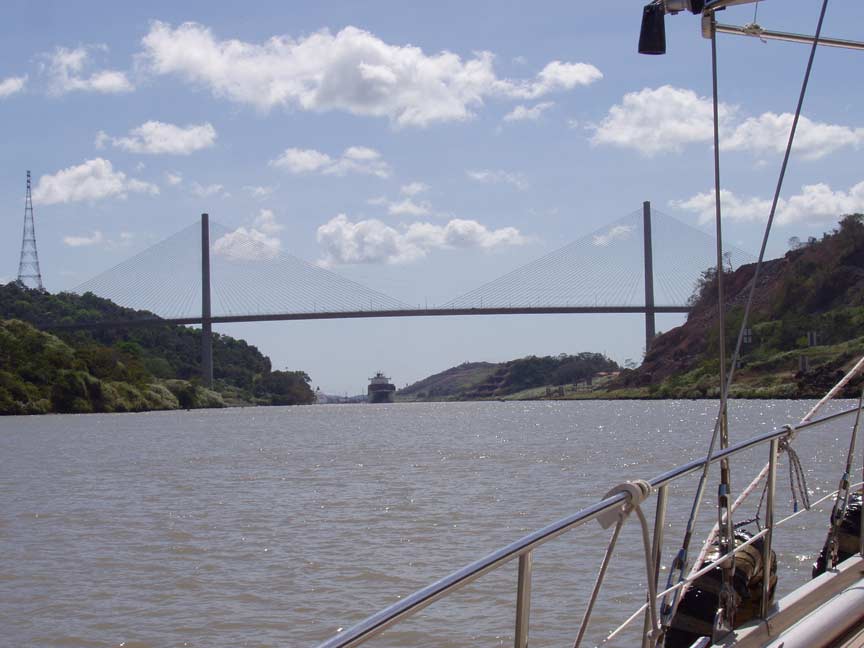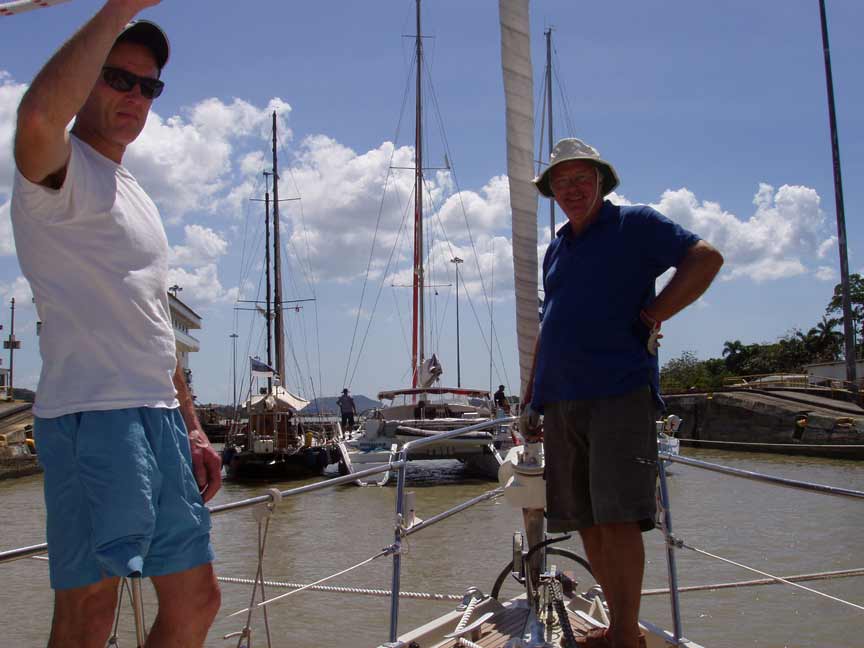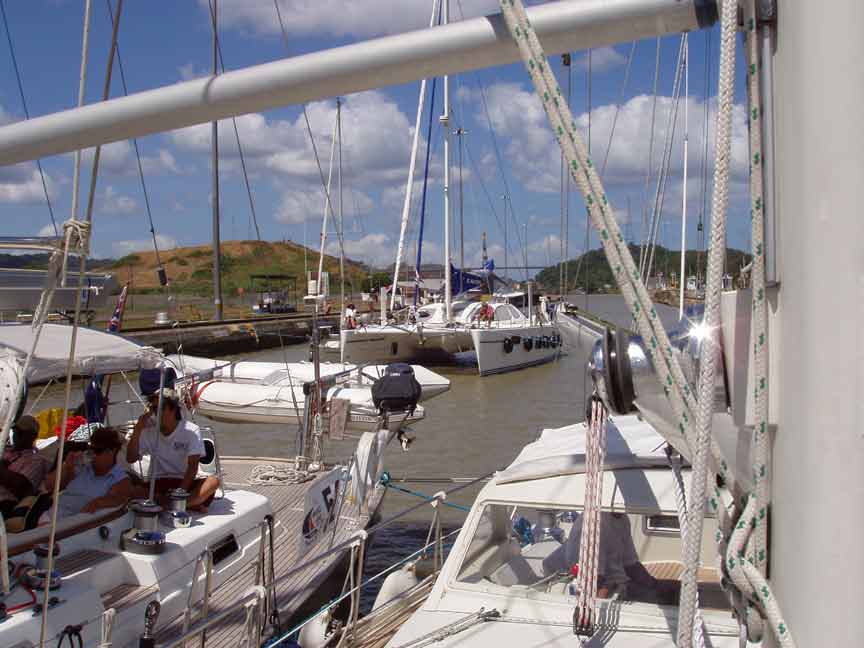Panama Canal Success!

Harmonie
Don and Anne Myers
Tue 5 Feb 2008 19:30
|
08:54.785N 79:31.288W
I apologize for the length of this
entry! A better writer could probably tell this story with fewer words...I
couldn't figure out how.
We arrived on the Pacific side of Panama Saturday
afternoon (2/2) after a two day excursion through the canal. We got the
word late last Thursday evening (during the champagne party on BlueFlyer) that
we, along with BlueFlyer (Ireland), Storyteller (Australia), Whitbread
(UK) and Southern Princess (Australia) were going to transit the canal
starting Friday evening, and finishing Saturday afternoon.
My brother Bill arrived without a hitch at around
2am on Thursday night (the taxi driver escorted him right to our boat) and after
a quick night's sleep, we scrambled around a bit on Friday to get ready for our
planned departure from the dock at 4:30pm. Crew from several other World
ARC boats had expressed interest in transiting the canal with us to gain
experience for their own transit, so we took them up on it and 'hired' two men
(Hilton and Michael) from Lady Kay (UK) to act as line handlers. Next
we needed six plastic covered tires to act as fenders and four 125 foot, one
inch diameter mega lines to use in the locks. We were able to rent the
tires easily enough through the Panama agent the rally is working with, and knew
that the four mega lines would also come from this agent. Unfortunately,
the lines our group of five boats needed were still in use by the group of rally
boats that were finishing up their own canal transit. We're still not
sure why there seemed to be such a shortage of lines, but an elaborate plan was
concocted to obtain the lines from the boats finishing the canal and get them to
our five boats before we entered the first lock. The plan went
something like this:
Match Ship (the Panama agent) would hire a small
launch (motor boat) on the Pacific side of the canal, catch up to the seven
rally boats just after they exited the last lock and collect the four mega
lines from each boat on the run. The Match Ship hired launch would then
zip to shore, transfer the lines to a Match Ship van and drive the lines back to
Colon on the Atlantic side of the canal (a two hour drive). Once
there, they would hire another launch, transfer the lines from the van to the
launch and motor out to our group of five boats which by that time
would be anchored in an area called 'The Flats' waiting for both our lines and
our canal advisors to board.
So, we five boats left the dock in Shelter Bay
at 4:30pm as planned and motored the short distance to The
Flats. There, we all anchored and proceeded to wait for both our lines and
our advisors. Time ticked by...5:30....6:30...Michael, one of our
'hired hands' from Lady Kay, suggested that it might be a good time
for some tea. In England, when waiting around for something to happen, tea
is often the diversion everyone turns to. Being the crass and
uncivilized American boat that we are, we had no tea to offer, much to the
disappointment of our English friends. Instead we opted for
dinner. As we were eating, we saw a pilot boat approach
Whitbread, the largest of our fleet of five boats. A pilot boarded
Whitbread (a pilot was required as opposed to an advisor because
Whitbread is over 65 feet in length). Shortly thereafter, Whitbread pulled
up their anchor and started heading for the first lock, which was a mile or two
away. We watched all of this and were all thinking the same
thing.....'They don't have their lines! How are they going to manage the
lock without lines??'. Suddenly we see a little, beat up boat speeding as
fast as it could possibly go, trying to catch up with Whitbread. The
boat did finally catch Whitbread and toss over the giant lines (not an easy
feat as each bundle of rope probably weighed close to 40 pounds and
was extremely bulky). After Whitbread received her lines, the launch
made its way around to the remaining four of us and we all breathed a collective
sigh of relief as we hauled the lines aboard.
Shortly thereafter, the pilot boat approached each
of the four boats and dropped off our respective advisors. By this
time, it was dark and windy at 20 knots. The pilot boats are quite
large and rightfully so as they are usually dropping pilots off on the big
ships, not tiny sailboats like ours. So there we sat as the
pilot boat loomed closer, and closer. We could see the shadow of our
advisor (not a small man) perched on the bow of the pilot boat, waiting for just
the right moment to jump aboard our boat. The bow of the pilot boat was
about even with the deck of our boat, but our sturdy stainless steel tube
lifelines were a barrier that the advisor had to gracefully hop over. In
the space of a few seconds, the pilot boat got its bow close enough to our
boat such that the advisor could hop over, clearing our life lines in the
process. As soon as the advisor's feet left the bow of the pilot boat, the
pilot boat backed up fiercely and went on its way to the next sailboat to drop
off another advisor. The whole episode
was incredibly impressive. The pilot boat never touched or even
brushed our boat, regardless of the darkness, wind and wave chop that existed at
the time. These guys obviously know their stuff.
Jose, our advisor, immediately put us at ease by
asking, 'So, how nervous are you about going through the
canal?'. When we all looked at him with white faces (some more than
others...Don and I would fall into that category), he laughed and said, 'Let me
give you the speech I give to all the small boats I advise through the
canal.....All the horror stories about smashed boats and terrible problems, are
just that, stories. If we take everything slow and carefully, we will be
just fine and at the end you will wonder why you were ever so
nervous." This was the point at which our adoration of Jose started
(at least for me). He next launched into his 'fender speech' (where to put
them, how high off the water, etc.) and then asked us to pull up our anchor
and get under way.
As my brother Bill discovered, transiting the
Panama Canal is an exercise in patience, a trait he is not
necessarily known for (but managed to survive the trip quite well despite
this). As described above, our first wait was in 'The Flats' as we
waited for our lines and our advisor. Once we got underway, we had to wait
another 1-2 hours before the first lock was ready for us. We spent
this wait motoring slowly back and forth in the channel, in the
dark, dodging the other boats that were doing the same thing, while Jose
talked and we listened. Finally, at around 9pm, the signal was given
- the lock was almost ready for us. The next step was for us to 'raft
up' with two other sailboats before entering the lock. Because the locks
are so wide and because the walls of the locks are so rough, small boats like
ours do not go into the locks alone and tie up to the wall (like we did
in both the Erie Canal and the St. Lawrence river locks). Instead,
small boats tie up side-by-side before entering the lock so that they
are two or three abreast, then the center boat uses its engine to
motor the 'raft' of boats into the center of the lock. So,
Southern Princess, which is a 57 foot boat, was the center boat of our 3-boat
raft for all six locks. Storyteller, another 57 foot boat rafted to
the starboard side of Southern Princess, and we rafted to the port
side. Southern Princess is not only larger than Harmonie, but
also has a more powerful engine, so she (and her captain John) maneuvered our
raft of three boats into and out of all the locks. As you can
imagine, this situation was a little uncomfortable for Don, who likes to be the
one in control at all times. Like Bill and his patience issue, Don
was also very well behaved even when not in
control.
After we three boats got assembled into our raft,
Southern Princess guided us into the first lock chamber. We were the third
set of rafted boats to enter the chamber (for a total of 8 or 9 boats) each raft
was situated in the center of the lock with at least 25-30
feet between the lock walls and the boats on either side of each
raft. The way in which the rafted boats were held in place was
something. When we entered the lock, two line handlers on land heaved a
line with a 'monkey fist' (a ball with a lead weight in it) on the end to
each of our line handlers, Michael on the bow and Hilton on the stern. The
same thing was done for Storyteller on the other side of our raft. When
the lines with the monkey fists came hurling through the air at us, we all
ducked and didn't make a good catch (it's hard to be coordinated when you've got
a lead ball coming at you in the semi-darkness). We quickly snatched up
the heaving lines from the deck and Michael and Hilton each tied the end
of a mega line to it and the line handlers on land pulled the heaving lines
back and secured our mega lines to giant bollards [non-boater translation:
like a cleat on a dock, only really big and bulbous shaped] near the lock
edge. Once this was accomplished, the four line handlers on each corner of
our 3-boat raft ensured that the lines were taut as the lock filled and the
boat rose. Picture 1 was taken during our first lock experience.
Southern Princess is the boat shown in the foreground, with Storyteller in the
background.
We stayed rafted with Southern Princess and
Storyteller through the three 'up' locks we transited on Friday
night. Once through the third lock, we disengaged ourselves (not easy in
the pitch black) and motored a short distance to the anchorage area in Gatun
Lake, which is the man made lake that sits at the highest elevation and feeds
the 'up' locks on the Atlantic side and the 'down' locks on the Pacific
side. By this time it was 12:30am. Jose ate some leftover
dinner while he waited for the pilot boat to pick him up and the rest of us
'decompressed' - too wound up to sleep. The pilot boat came, and it and
Jose performed the same amazing feat in reverse - the big boat hovering
just close enough for Jose to leap aboard and the boat backing off so fast
that it never touched us. I applauded, but I'm not sure the pilot
boat guys appreciated my appreciation. After that
(1:30am) we all fell into bed (Hilton and Michael included - but not
all in the same bed) knowing that we had to be ready for our new advisor to
arrive between 6 and 6:30am the next morning.
We were all up by six the next morning - partly due
to the alarm clock we have in our cabin and partly due to the howling monkeys
that were yelling at each other in the jungle beside the lake.
Seriously. They were howling. Really, really loud. At
first it sounded like some freaky dogs barking and when everyone told me it
was howling monkeys, I honestly thought they were kidding. I hadn't
heard Jose talk about them the night before. But apparently that's exactly
what they were, howling monkeys. The yelling started at one end of the
wooded area and made its way to the other. Perhaps this was the monkeys'
way of saying good morning to each other (and to us)?
Our new advisor, Adrian, arrived in the same
flamboyant fashion on the pilot boat at around 6:30am. We had breakfast,
pulled up the anchor and motored through the 'Banana Cut' in Gatun Lake, which
to us seemed like the Thousand Islands, but with palm trees instead of
evergreens (picture 2). After a very pleasant motor through the lake,
we entered the narrowest part of the canal, the Gaillard Cut. Here,
dredging is a constant process as they slowly widen this section of the canal
and attempt to keep the depth between 50-75 feet. We passed a massive
dredging operation (picture 3), where the mud and silt was being pumped from the
bottom, through a giant pipeline to a location almost a mile away on shore,
where it was dumped. We also passed under the new Panamerican Highway
bridge that crosses the canal before the 'down' locks to the Pacific (picture
4). Note the giant cargo ship headed right for us. The canal seemed
to get narrower each time we encountered a ship going the opposite
way.
We arrived at the first of the three 'down' locks
at around 11:15am and proceeded to raft up with our mother ship Southern
Princess and Storyteller. We entered the lock and waited
there for about an hour (another exercise in patience).
Whitbread's pilot boarded very late back in Gatun Lake, which caused all of
us to wait for them to catch up. Once Whitbread showed up, the lock
procedure started and we made it through the three down locks with no
trouble at all. My brother Bill and Michael, our bow line
handlers, are shown in picture 5, with the raft of boats ahead of us shown in
the background. Picture 6 shows Southern Princess beside us with another raft of
boats behind.
Shortly after we exited the last lock, when
we were enjoying our first taste of Pacific Ocean air (it does seem
different than the Atlantic by they way, not sure why, but it does), we noticed
a small, beat-up motor boat speeding across the water coming toward
us. We were concerned for a moment before we realized it was the
people from Match Ship, come to collect our mega lines for the next group of
rally boats to use. They pulled along side us and as we continued forward
at a good pace, Hilton heaved the giant bundles of mega lines (we had four even
though we only used two) into the Match Ship boat. We threw in the six
fender tires for good measure, and Match Ship left us to go
collect from the next boat. At this point, it was close to 3pm so we
wondered whether the next group of boats would get their lines before or after
they left The Flats for the first lock. Hmmmm.
The rest of the trip was easy as we motored a
little further into the Pacific and rounded Flamenco Island to
find Flamenco Marina where we are now docked. We arrived at
about 3:30pm and Match Ship whisked our marvelous line handlers, Michael and
Hilton, away and back to Shelter Bay where their wives and boat were waiting to
do their own canal transit. The three of us celebrated our successful
travels with dinner out at Bennigans, yup, the US chain - how sad that we
came all the way to the Pacific side of Panama only to eat at a chain
restaurant. Needless to say we all slept very well that night -
starting early at about eight o'clock.
So that's our Panama Canal story. The boat
did not get damaged (nor did anyone else's), nothing awful happened, both of our
advisors were excellent, we had lots of good help between Bill, Michael and
Hilton, and the only disturbing thing that occurred was waking up to
howling monkeys (which was maybe more intriguing than disturbing). If you
were to ask Don a week ago what he was most concerned about, he would
have told you that going through the Panama Canal concerned him far
more than any other part of our planned voyage. Now that we have the
relatively painless transit behind us, I wonder if the rest of our trip
will really be easier? Let's hope so.
Anne
|
